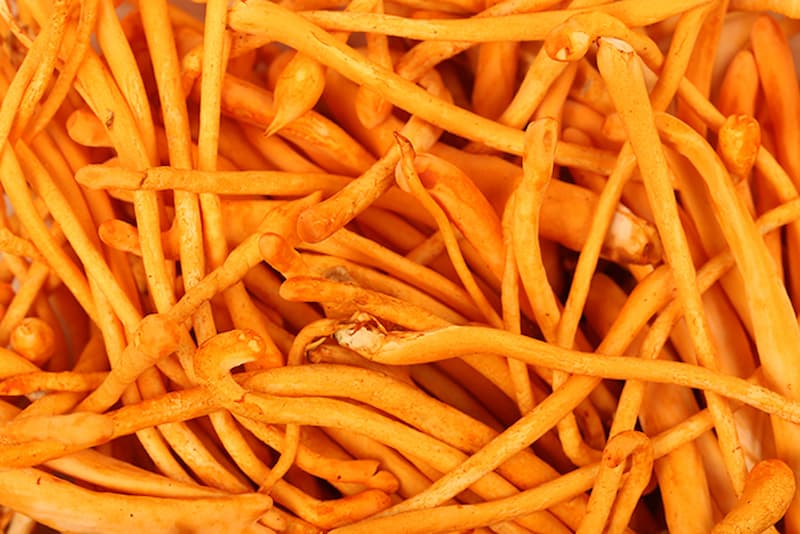(Franz Walker) In a bid to find new treatments for diabetes mellitus, Chinese scientists investigated Cordyceps taii, a medicinal mushroom from southern China, to see if it can be used as a possible treatment against the disease.
Related China Began Subjecting American Diplomats To Anal COVID-19 Tests Right After Biden Was Inaugurated.
by Franz Walker, January 31st, 2022
Diabetes mellitus is a chronic and systemic metabolic disease characterized by hyperglycemia and abnormalities in lipoprotein and lipid metabolism. It can result in complications, such as hypertension, hyperlipidemia and atherosclerosis.
According to the International Diabetes Foundation, approximately 629 million people will have diabetes mellitus by the year 2045.
Cordyceps mushrooms are used in Traditional Chinese Medicine (TCM) to treat many diseases. In particular, the polysaccharides from C. taii have been recognized for their therapeutic potential. Studies show that C. taii polysaccharides (CTP) demonstrate antioxidant and immunoenhancing activities. (Related: Cordyceps: A strange fungi packed with a lot of health benefits.)
At the same time, polysaccharides from other Cordyceps species, such as C. cicadae, have already been found to demonstrate potent anti-diabetes effects in previous studies. With this in mind, researchers from the Affiliated Hospital of Zunyi Medical University decided to investigate whether CTP also displays anti-diabetes effects.
The study’s findings were published in the journal BMC Complementary and Alternative Medicine.
Testing CTP in STZ-induced diabetic mice
For their study, the researchers first induced diabetes in adult male Kunming mice. To do this, the mice were injected with streptozotocin (STZ), a compound derived from Streptomyces achromogenes.
STZ can induce a diabetic state in two ways, depending on the dose. STZ damages pancreatic B cells, resulting in hypoinsulinemia and hyperglycemia, inducing a diabetic state.
For the experiment, the mice were given STZ, dissolved in an ice-cold 0.1 mil/L citrate buffer at a dose of 100 milligrams per kilogram (mg/kg) of bodyweight. After the disease was induced, the mice were then divided into five groups. These were the diabetic mellitus group (DM), metformin-treated group (MET) and low, medium and high-dose CTP-treated groups (CTP-L, CTP-M and CTP-H). In addition, a sixth group with normal mice served as a control.
For the treatment, CTP and metformin were dissolved in 1.0 milliliter (mL) of normal saline. The mice were dosed with the CTP and metformin mixture by gavage once daily. The control and DM groups, on the other hand, were only given 1.0 mL normal saline.
The treatments lasted for 28 days. During this time, body weights and fasting blood glucose (FBG) levels were measured at one week intervals after the CTP was administered. On the 28th and final day of treatment, the researchers measured each groups’ fasting serum insulin (FSI), FBG, homeostasis model assessment-insulin resistance (HOMA-IR), triglyceride (TG), total cholesterol (TC), low-density lipoprotein-cholesterol (LDL-C), high-density lipoprotein-cholesterol (HDL-C), tumor necrosis factor-a (TNF-a), interleukin-6 (IL-6) and C-reactive protein (CRP) levels.
Oral CTP shows promise as diabetes treatment
One of the symptoms of diabetes mellitus is a decrease in body weight. As such, the researchers investigated the changes in the mice’ body weight during the experimental period.
Initially, they did not note a significant difference in body weights among all the groups. But after seven days, the body weights of the DM and MET groups were lower than that of the control group by 10.71 percent and 10.13 percent respectively. Meanwhile, the body weights of the CTP-L, CTP-M and CTP-H groups were only 5.62, 3.83 and 3.11 percent lower than that of the control.
By the end of the experiment, the body weights of the MET, CTP-L, CTP-M and CTP-H were significantly higher than that of the DM group. Of all these groups, it was the CTP-H group that showed the greatest weight gain.
In addition, the researchers noted similar patterns with the other markers for diabetes that they tracked. For example, compared to the control group, all the groups with STZ-induced diabetic mice showed an evident increase in FBG levels. However, all treatment groups exhibited significant decreases in FBG levels compared to the untreated DM group.
The results also showed that the CTP groups also had increased levels of serum insulin and significantly reduced levels of insulin resistance, in a dose-dependent manner, compared to the untreated DM group. As part of this, the researchers noted that the high dose CTP-H group strongly reversed their HOMA-IR values compared to the metformin-treated MET group.
With this data, the researchers concluded that CTP had potent glucose-lowering and hypolipidemic effects. As such, they suggest that CTP can be a potential candidate for developing therapeutic drugs and functional foods for treating diabetes and its complications.
Follow PreventDiabetes.news for more research on novel diabetes treatments.
Stillness in the Storm Editor: Why did we post this?
The news is important to all people because it is where we come to know new things about the world, which leads to the development of more life goals that lead to life wisdom. The news also serves as a social connection tool, as we tend to relate to those who know about and believe the things we do. With the power of an open truth-seeking mind in hand, the individual can grow wise and the collective can prosper.
– Justin
Not sure how to make sense of this? Want to learn how to discern like a pro? Read this essential guide to discernment, analysis of claims, and understanding the truth in a world of deception: 4 Key Steps of Discernment – Advanced Truth-Seeking Tools.
Stillness in the Storm Editor’s note: Did you find a spelling error or grammatical mistake? Send an email to [email protected], with the error and suggested correction, along with the headline and url. Do you think this article needs an update? Or do you just have some feedback? Send us an email at [email protected]. Thank you for reading.
Source:
https://www.naturalnews.com/2022-01-31-medicinal-mushroom-lowers-blood-sugar-blood-lipid.html
Support our work! (Avoid Big Tech PayPal and Patreon)DIRECT DONATION


Leave a Reply